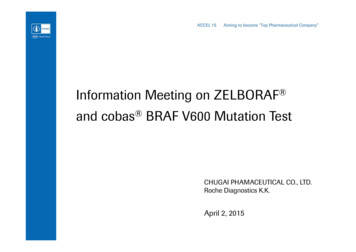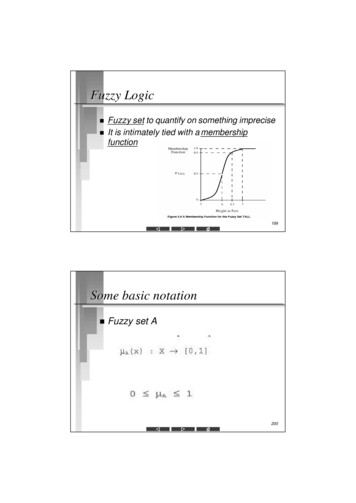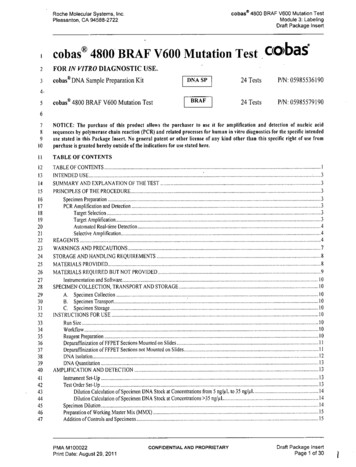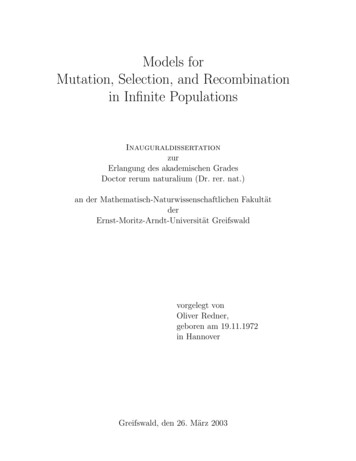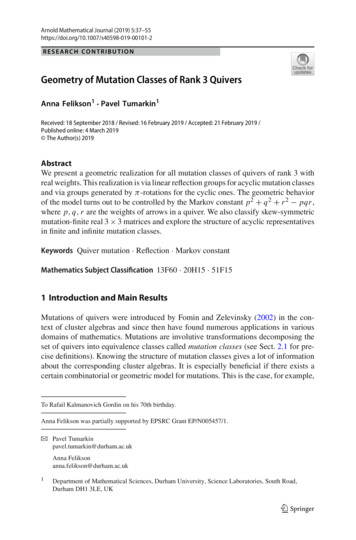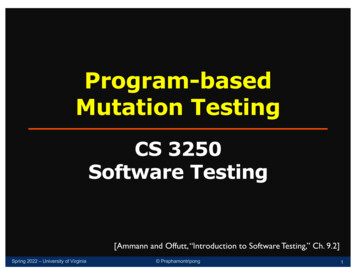
Transcription
Khovanov-Rozansky Homology and MutationThomas JaegerMichigan State UniversitySaturday, December 4, 2010Knots in Washington XXXIThomas Jaeger (MSU)Khovanov-Rozansky Homology and MutationSaturday, December 4, 2010
OutlineConway MutationInvariants and MutationStatement of the Main TheoremNormalizing Orientation-Preserving MutationKhovanov-Rozansky HomologyA State ModelMutation InvarianceIdeaKey LemmaApplication of the LemmaProof of the Main TheoremFuture DirectionsQuestions and Open ProblemsThese slides and a draft of my paper are available on my website athttp://math.msu.edu/ tjaeger.Thomas Jaeger (MSU)Khovanov-Rozansky Homology and MutationSaturday, December 4, 2010
Conway MutationInvariants and MutationInvariants and MutationMany invariants cannot distinguish mutants:IAlexander PolynomialI(Colored) Jones Polynomial(Morton-Traczyk)IHOMFLY-PT PolynomialIKauffman PolynomialIHyperbolic Volume (Ruberman)IDouble-Branched CoverIZ2 and odd Khovanov Homology(Bloom, Wehrli)The Kinoshita-Terasaka Conway PairHowever, there are some invariants that can tell mutants apart:IColored sl(n) Polynomial and finite type invariants of order 11(Cromwell-Morton)IKnot Floer Homology (via Knot Genus)Thomas Jaeger (MSU)Khovanov-Rozansky Homology and MutationSaturday, December 4, 2010
Conway MutationStatement of the Main TheoremStatement of the Main TheoremTheorem (J.)If two knots are related by positive (“orientation-preserving”) mutationand n is odd, then their reduced sl(n) homologies are isomorphic.Positive and Negative MutationOf the 16 mutant pais with 11 crossings, I found 5 that can be realized onthe tangle below and thus can be realized by both positive and negativemutation, among them the Kinoshita-Terasaka - Conway pair.RxThomas Jaeger (MSU)RyKhovanov-Rozansky Homology and MutationRzSaturday, December 4, 2010
Conway MutationNormalizing Orientation-Preserving Mutation······ Thomas Jaeger (MSU)The two possible orientations of theendpoints of a tangle. Note that there isonly one type of positive mutation in eachcase.We can use a modification of the proof ofAlexander’s Theorem to transform a tangleof typeinto what we call braid form. typetype Reduction to Braid FormThe example from the beginning already isin braid form.Khovanov-Rozansky Homology and MutationSaturday, December 4, 2010
Reduction to Tangles of TypeNormalizing Orientation-Preserving Mutation Conway MutationIf the inner tangle is of type , we can perform a topologically equivalentmutation on a tangle of type .R R RThomas Jaeger (MSU) RKhovanov-Rozansky Homology and MutationSaturday, December 4, 2010
Khovanov-Rozansky HomologyA State ModelThe sl(n) Skein Module of Singular BraidsThe sl(n) skein module is generated by tangles modulo skein relations (q q 1 ) qn,and q n.Theorem (Murakami, Ohtsuki, Yamada)Set: q q 1 to extend the invariant tosingular tangles. Then ([k] q k 1 q k 3 . . . q k 1 ) [n 1] [n] [2] These relations determine the sl(n) polynomial for closed fully singularbraids.Thomas Jaeger (MSU)Khovanov-Rozansky Homology and MutationSaturday, December 4, 2010
Khovanov-Rozansky HomologyA State ModelKhovanov-Rozansky Homology of Singular BraidsKhovanov-Rozansky homology is a categorification of the sl(n) polynomial.It has a particular simple form for fully singular braids: All complexes aresupported in homological height 0 and satisfy the following isomorphisms.!!!nnn C{ n 1} . . . C{n 1}C !C! Cnn!!Cn! Cn{ n 2} . . . C! CnCn! C{n 2}!{1} C n!nn{ 1}! CnThese complexes live in the homotopy category of chain complexes overthe homotopy category of matrix factorizations with a certain potentialassociated to the endpoints.Thomas Jaeger (MSU)Khovanov-Rozansky Homology and MutationSaturday, December 4, 2010
Khovanov-Rozansky HomologyA State ModelKhovanov-Rozansky Homology of BraidsUsing!! CnCn[ 1] C n!C{1}! Cn!nand!{ 1} Cn[1]we extend the invariant to braids via a “cube of resolutions”:!!Cn Cn Cn !CnThomas Jaeger (MSU){1} !{1}Khovanov-Rozansky Homology and MutationCn{2}Saturday, December 4, 2010
Khovanov-Rozansky HomologyA State ModelKhovanov-Rozansky Homology of 2-Tangles 4 4 4n 4 4(n 1) 4 4(n 1)···Khovanov-Rozansky Homology of anytangle in braid form is isomorphic to achain complex built out! of direct sums!of shifts of C nThomas Jaeger (MSU)and C n 8(n 1).Khovanov-Rozansky Homology and MutationSaturday, December 4, 2010
Mutation InvarianceIdeaIdea of the proofISo far, we have expressed the inner tangle as a chain complex over aparticularly simple category: the full! subcategory of! our category ofmatrix factorizations on C nand C n.Reflection/rotation (denoted by ·) also has a simple description in thiscategory.Thomas Jaeger (MSU)Khovanov-Rozansky Homology and MutationSaturday, December 4, 2010
Mutation InvarianceIdeaIdea of the proofISo far, we have expressed the inner tangle as a chain complex over aparticularly simple category: the full! subcategory of! our category ofmatrix factorizations on C nand C n.Reflection/rotation (denoted by ·) also has a simple description in thiscategory.IFollowing the proof of mutation invariance for the sl(n) polynomial,we’d like to be able to say that any such chain complex is invariantunder ·, but this is false.Thomas Jaeger (MSU)Khovanov-Rozansky Homology and MutationSaturday, December 4, 2010
Mutation InvarianceIdeaIdea of the proofISo far, we have expressed the inner tangle as a chain complex over aparticularly simple category: the full! subcategory of! our category ofmatrix factorizations on C nand C n.Reflection/rotation (denoted by ·) also has a simple description in thiscategory.IFollowing the proof of mutation invariance for the sl(n) polynomial,we’d like to be able to say that any such chain complex is invariantunder ·, but this is false.IInstead, we will try to kill enough information to obtain a complexthat is invariant under · while retaining enough information to recoverthe homology of the link — provided that we are promised an endpoint of the tangle and its image under · lie on the same component.Thomas Jaeger (MSU)Khovanov-Rozansky Homology and MutationSaturday, December 4, 2010
Mutation InvarianceIdeaIdea of the proofISo far, we have expressed the inner tangle as a chain complex over aparticularly simple category: the full! subcategory of! our category ofmatrix factorizations on C nand C n.Reflection/rotation (denoted by ·) also has a simple description in thiscategory.IFollowing the proof of mutation invariance for the sl(n) polynomial,we’d like to be able to say that any such chain complex is invariantunder ·, but this is false.IInstead, we will try to kill enough information to obtain a complexthat is invariant under · while retaining enough information to recoverthe homology of the link — provided that we are promised an endpoint of the tangle and its image under · lie on the same component.ITo do so, we will consider a certain mapping cone of the complex.Thomas Jaeger (MSU)Khovanov-Rozansky Homology and MutationSaturday, December 4, 2010
Mutation InvarianceKey LemmaKey LemmaLet C be an additive category and let · : C C be a functor that is theidentity on objects and an involution on morphisms. Furthermore, let f bean element in the center of C and : HomC (A, B) HomC (A, B) be aZ-linear operation with the following propertiesIFor φ HomC (A, B), φ φ̄ fB φ φ fA .IComposable morphisms φ HomC (A, B) and ψ HomC (B, C )satisfy (ψ φ) ψ φ ψ̄ φ ψ φ̄ ψ φ.If C is a chain complex over C with differential d, then f gives rise to achain morphism fC : C C . Let C̄ be the chain complex obtained byapplying · to the differential of C . Then the mapping cones Cone(fC ) andCone(fC̄ ) are isomorphic.Proof (mod 2). dfC dThomas Jaeger (MSU) I d IC [ 1] C C [ 1] CKhovanov-Rozansky Homology and Mutation d̄fC̄ d̄Saturday, December 4, 2010
Mutation InvarianceApplication of the LemmaWarmupOne object: x y/ (xn y n 0)Recall that φ φ̄ φ f and (ψ φ) ψ φ ψ̄ φ.Reflection is given by x̄ y and ȳ x. Set f x y . It follow thatf x x x̄ x y x 1f x y ȳ y x y 1We compute (x 2 ) x x x̄ x x y (y 2 ) y y ȳ y (x y ) (x 3 ) x x 2 x̄ (x 2 ) x 2 y (x y ) x 2 xy y 2 (y 3 ) y y 2 ȳ (y 2 ) y 2 x( (x y )) y 2 xy y 2Thomas Jaeger (MSU)Khovanov-Rozansky Homology and MutationSaturday, December 4, 2010
Mutation InvarianceApplication of the LemmaWarmupOne object: x y/ (xn y n)Recall that φ φ̄ φ f and (ψ φ) ψ φ ψ̄ φ.Reflection is given by x̄ y and ȳ x. Set f x y . It follow thatf x x x̄ x y x 1f x y ȳ y x y 1We compute (x 2 ) x x x̄ x x y (y 2 ) y y ȳ y (x y ) (x 3 ) x x 2 x̄ (x 2 ) x 2 y (x y ) x 2 xy y 2 (y 3 ) y y 2 ȳ (y 2 ) y 2 x( (x y )) y 2 xy y 2Thomas Jaeger (MSU)Khovanov-Rozansky Homology and MutationSaturday, December 4, 2010
Mutation InvarianceApplication of the LemmaThe Category Associated to 2-TanglesR Q[a, b, c, d]/(a b c d), q R a certain polynomial of degreen 1.ObjectsMorphismscdaRocbc a(c b)qd/aRRoRoxb(c a)(c b)q/R Ro /R/ yR(modulo homotopy)ReflectionReflection Ry is given by the ring homomorphism · : R R, a 7 b,b 7 a, c 7 d, d 7 c. Here we use that n is odd.Differentialf a b c d, a b c d 1, hence (c a) 0 and (c a)(c b) 0 and also q 0, so we may define (x, y ) ( x, y )for any morphism (x, y ). This operation also descends to homotopy.Thomas Jaeger (MSU)Khovanov-Rozansky Homology and MutationSaturday, December 4, 2010
Mutation InvarianceProof of the Main TheoremWrapping it upThere is an action of the “edge ring” on Cn (T ) such that a ' b if edges aand b lie on the same component of the tangle T . For a link L, reducedKhovanov-Rozansky homology (wrt. the component that a lies on) can bea defined by Hn (L) H Cone Cn (L) Cn (L) .Let K1 T T 0 and K2 T̄ T 0 be mutant knots. Applying the Lemmato T , we see that a ba bCone Cn (T ) Cn (T ) Cone Cn (T̄ ) Cn (T̄ ) Closing up (by taking Cn (T 0 )), we get a ba b Cone Cn (K1 ) Cn (K1 ) Cone Cn (K2 ) Cn (K2 ) 2aCone Cn (K1 ) Cn (K1 )Thomas Jaeger (MSU) 2aCone Cn (K2 ) Cn (K2 )Khovanov-Rozansky Homology and MutationSaturday, December 4, 2010
Future DirectionsQuestions and Open ProblemsQuestionsIIs it possible to lift some of the restrictions of the Theorem? Inparticular,IIIICan the method be applied to other homological knot invariants?IIIIICan the proof be extended to unreduced Homology?Can we extend the argument to negative mutation?How about even n, particularly n 2, i.e. Khovanov Homology?Rasmussen’s s-invariant?HOMFLY-PT Homology? (Answer: Yes)Rasmussen’s spectral sequance from sl(n) to HOMFLY-PT Homology?Can Bloom’s invariance result for odd Khovanov homology bere-proved using Putyra’s formalism?Can a generalization of the Lemma be used to show invariance ofZ2 -Khovanov Homology under genus-2 mutation?Thomas Jaeger (MSU)Khovanov-Rozansky Homology and MutationSaturday, December 4, 2010
Positive and Negative Mutation. Of the 16 mutant pais with 11 crossings, I found 5 that can be realized on the tangle below and thus can be realized by both positive and negative mutation, among them the Kinoshita-Terasaka - Conway pair. R. x. R. y. R. z. Thomas Jaeger (MSU)Khovanov-Rozansky Homology and MutationSaturday, December 4, 2010
